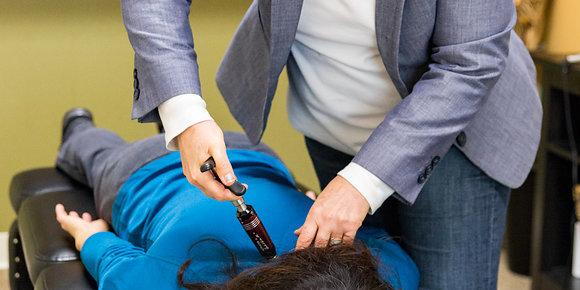ADHD And Chiropractic: Why It Works!

- posted: Sep. 20, 2011
From a study published in the J Manipulative Physiol Ther 2004 (Oct); 27 (8): e14 Bastecki AV, Harrison DE, Haas JW
OBJECTIVE:
To discuss the case of a patient who was diagnosed with attention-deficit/hyperactivity disorder (ADHD) by a general practitioner and was treated with chiropractic care.
CLINICAL FEATURES:
A 5-year-old patient was diagnosed with ADHD and treated by a pediatrician unsuccessfully with methylphenidate (Ritalin), Adderall, and Haldol for 3 years. The patient received 35 chiropractic treatments during the course of 8 weeks. A change from a 12 degrees C2-7 kyphosis to a 32 degrees C2-7 lordosis was observed after treatment. During chiropractic care, the child's facial tics resolved and his behavior vastly improved. After 27 chiropractic visits, the child's pediatrician stated that the child no longer exhibited symptoms of ADHD. The changes in structure and function may be related to the correction of cervical kyphosis.
CONCLUSION: The patient experienced significant reduction in symptoms. Additionally, the medical doctor concluded that the reduction in symptoms was significant enough to discontinue the medication. There may be a possible connection that correction of cervical kyphosis in patients with ADHD may produce a desirable clinical outcome.
From the Full-Text Article:
Discussion There exists in the current biomedical literature an ideal cervical spinal model, [17] which was used as a goal of care in this case study. It is generally known in neurosciences and anatomy that the central nervous system is the master control system of the human body. It controls and coordinates all body and cellular functions. When we look at the literature today, there has been a significant amount of information published about the mechanical forces and tension placed on the spinal structures and cord tracts in various postures. [25-36] Breig [26] showed the changes in spinal cord biomechanics from abnormal postural positions.
We propose that these changes in spinal canal and thus spinal cord position can cause such pathologic states as edema, hypoxia, blood loss, and cellular death. [28-36] It has been reported by some researchers that abnormal putamen and lenticular magnetic resonance imaging and positron-emission tomography have been observed in children with ADHD. [37, 38] The previous refrences [28-36] may give insight to these abnormal scans. The underlying cause of the mechanical and thus physiologic changes in the spinal cord, brainstem, and higher brain centers are related to the abnormal static postural positions of the skull relative to the thorax. [26] Mechanical compression of nerves can result in microvascular permeability changes in the endoneural capillaries and lead to neural edema and changes in impulse propagation. [28-36]
Additionally, it has been shown that gradual decompression of nerve roots can restore the intrinsic blood flow. [36] Because the parents reported no other major traumatic injuries to the child other than a difficult birth, we propose that the cause of the abnormal spinal configuration was a result of difficult labor. Because of the vast amount of information concerning abnormal nerve function caused by mechanical stress in neck flexion (kyphosis), [26, 39, 40-45] it stands to reason, because his neck configuration was kyphotic, that the child's nervous system was not functioning properly. Through the restoration of normal biomechanical structure and curvature, these abnormal stresses and strains were removed from the cord, which led to the improvement in function. There exists a large amount of literature on ADHD. This literature is generally pharmacologic and behavioral in nature.
Many theories of causality and subsequent treatment have been put forth. However, because chiropractors are not authorized in most states to prescribe drugs, the pharmacologic information has little bearing for chiropractors. The chiropractors who treat patients with ADHD should, however, familiarize themselves with the current diagnostic and treatment protocols used by physicians. Medication may have an effect on treatment outcomes and may be an important factor in proper management of this condition. [1-15]
It should be noted that these references are nowhere near a complete review of the literature on ADHD. It is possible that the farther we move from the Harrison ideal spinal model, [17] the greater the neurologic stress from abnormal stress and strain on the spinal cord. [26] Restoring the cervical lordosis could be the most critical aspect of any chiropractic care protocol or clinical intervention. With specific mirror image adjusting, mirror image traction, and mirror image postural exercise, cervical curve restoration is now a possible outcome. [18-21]
Several limitations of this study include:
(1) a possibility that there was spontaneous remission of the ADHD symptoms and that chiropractic care had no relevance to the symptom remission;
(2) the patient may have been misdiagnosed by the medical doctor; and (3) the patient's parents may not have been reporting the retrospective symptoms accurately, giving a false sense of improvement. Because this is a case report, further research is needed to determine the true effects of CBP protocol on patients suffering with ADHD.
Conclusion:
This case study shows that spinal correction using the CBP approach may have effects much greater than relief of musculoskeletal conditions. Altered spinal biomechanics associated with abnormal posture clearly relate to significant neurological stress and malfunction. This is particularly evident when considering the effects on the brainstem and the autonomic nervous system.
Chiropractors have known the benefits of chiropractic since 1895. Keeping your body working correctly allows for total health and wellness. Our San Francisco, CA chiropractor and San Carlos, CA chiropractor can help you be the best you can be. Contact us today!
https://www.journals.elsevierhealth.com/periodicals/ymmt/article/PIIS0161475404001642/fulltext
Location
Find us on the map - Please click desired location below
Precise Moves Chiropractic San Francisco
3150 18th Street, Suite 334
San Francisco, CA 94110, United States
24 hour Scheduling makes it easy!
(Hours may change due to doctor availability)
Hours in the mission district, San Francisco
8-12pm
Closed
3-6PM
8-12PM
3-8PM
8:00 am - 12:00 pm
Closed
